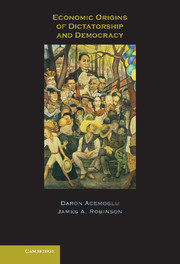Book contents
- Frontmatter
- Contents
- Preface
- PART ONE QUESTIONS AND ANSWERS
- PART TWO MODELING POLITICS
- PART THREE THE CREATION AND CONSOLIDATION OF DEMOCRACY
- PART FOUR PUTTING THE MODELS TO WORK
- 8 The Role of the Middle Class
- 9 Economic Structure and Democracy
- 10 Globalization and Democracy
- PART FIVE CONCLUSIONS AND THE FUTURE OF DEMOCRACY
- PART SIX APPENDIX
- Bibliography
- Index
8 - The Role of the Middle Class
Published online by Cambridge University Press: 05 September 2012
- Frontmatter
- Contents
- Preface
- PART ONE QUESTIONS AND ANSWERS
- PART TWO MODELING POLITICS
- PART THREE THE CREATION AND CONSOLIDATION OF DEMOCRACY
- PART FOUR PUTTING THE MODELS TO WORK
- 8 The Role of the Middle Class
- 9 Economic Structure and Democracy
- 10 Globalization and Democracy
- PART FIVE CONCLUSIONS AND THE FUTURE OF DEMOCRACY
- PART SIX APPENDIX
- Bibliography
- Index
Summary
Introduction
In Part 4, we put the basic models of democratization and coups to work in a number of different settings. To keep things simple, we do this only in the context of our basic extensive-form static game in which the commitment problem is modeled in a reduced-form way. Our aim is to show the utility of the framework we developed for thinking about why some countries are democratic and others are not and illustrate some ways in which the framework can be enriched and extended. We also keep the analysis and statements of results more informal than in the book so far. For instance, we do not present formal specifications of strategies, although it will be straightforward to fill in the details from the analysis already presented.
In this chapter, we extend our framework by allowing for a third group with interests intermediate to those of the elites and the great mass of citizens. For simplicity, we call this group the middle class. Our model has focused on the political conflict between the elites and the citizens. Clearly, real-world societies do not correspond to our simple model with only two groups. Just as the distinctions between the elites and the citizens and the rich and the poor are useful as a tractable device for developing ideas, so is the three-class model (another application of Occam's razor).
- Type
- Chapter
- Information
- Economic Origins of Dictatorship and Democracy , pp. 255 - 286Publisher: Cambridge University PressPrint publication year: 2005



